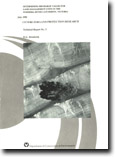Salinity Technical Reports
Salinity Monitoring Reports
To view the information PDF requires the use of a PDF reader. This can be installed for free from the Adobe website (external link).
Landform Mapping and Recharge Estimations from Horsham to Dimboola
B.J. Muller and M. Hocking (April 2002). DPI Centre for Land Protection Research. Technical Report No. 90.
Twenty-one landform units were identified within the Horsham to Dimboola study area and an estimate of groundwater recharge from hydrograph fluctuations was determined for each unit. Low-lying landform units were shown to have higher recharge rates due to greater contributions during rainfall events by surface and shallow sub-surface flow, causing accumulation of water at these points in the landscape, thus increasing the potential for groundwater recharge. Landform units of greater extent but with lower recharge values are of as much, if not greater, concern to salinity problems in the area. A partial water balance revealed that an average 16% of rainfall in the region contributes to groundwater recharge.
 |
Salinity Change in the West Wimmera
B.J. Muller and M. Hocking (September 2002). DPI Centre for Land Protection Research. Technical Report No. 92.
A key factor in understanding the processes that cause salinity in the West Wimmera region is the development of an inventory of saline sites in the area. Polygons created for salinity maps become one of the fundamentals of salinity investigation. What is sometimes overlooked is the change that these sites have undergone with time, and the identification of primary salinity (naturally saline) or secondary induced salinity (caused by changes in land use associated with post European settlement). Aerial photograph series dating back to the 1940s have been assessed in an attempt to identify changes in salinity in the Edenhope and Telopea Downs areas of the West Wimmera region. The study has shown that there has been significant change at the investigated sites. In the Edenhope area there was a notable increase in the spread and severity of salinity up until the 1980s, but photographs since then appear to reveal reductions in salinity. At Telopea Downs evidence of tree growth before land clearance in presently saline sites suggests that the present salinity is of secondary nature. The severity and occurrence of salinity in the West Wimmera region appears to be highly influenced by climatic conditions, the current apparent reduction of salinity interpreted to be a consequence of the prevailing low rainfall period.
 |
This report: 'Determining Recharge Values for Land Management Units in the Wimmera River Catchment, Victoria' was prepared by Darryl Strudwick from the former Department of Conservation and Environment in 1992. It was prepared as a requirement of the then Wimmera River Sub-Regional Salinity Management Plan, and drew together information that was currently known, as well as theories for discussion. It provided an estimation of groundwater recharge occurring under each of the twenty one Land Management Units (LMUs) of the Wimmera River Catchment.
 |


